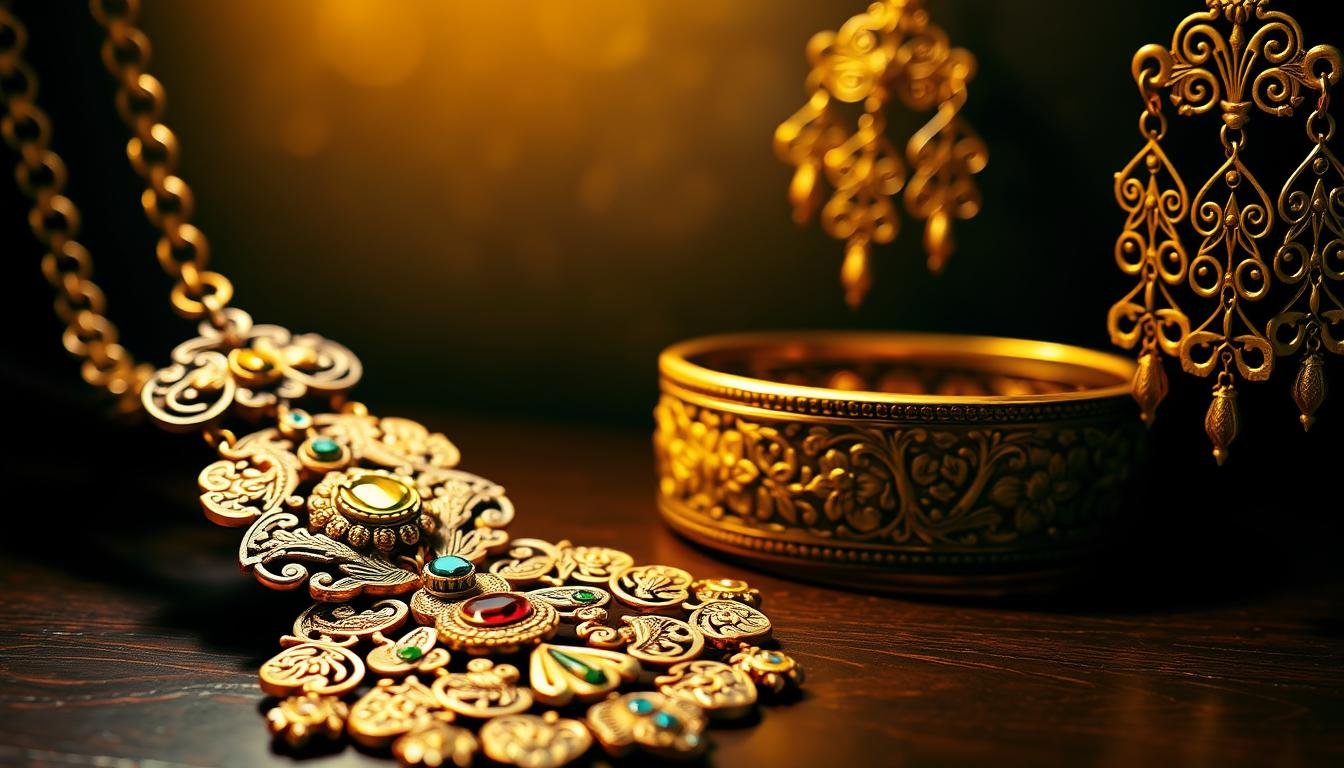Did you know the Philippines holds the second-largest gold deposit in the world? This abundance of gold has shaped the nation’s history, particularly in the creation of stunning adornments. Ancient Filipino jewelry is more than just decoration—it’s a celebration of heritage, artistry, and symbolism.
From intricate gold dental decorations found in the Bolinao Skull to the loop-in-loop technique of Surigao waistbands, these pieces reflect the advanced craftsmanship of pre-colonial times. Each design tells a story, blending indigenous techniques with cultural narratives that continue to inspire modern collections.
Today, brands like AMAMI are preserving these traditions by incorporating ancient motifs into contemporary designs. Their commitment to sustainability and ethical craftsmanship ensures that every piece honors the past while embracing the future.
Key Takeaways
- Ancient Filipino adornments showcase advanced goldsmithing techniques.
- These pieces are deeply rooted in cultural heritage and symbolism.
- Modern designs blend traditional methods with contemporary styles.
- Ethical craftsmanship ensures fair compensation for artisans.
- Gold deposits in the Philippines have influenced jewelry-making for centuries.
The Rich Heritage of Filipino Jewelry
Long before modern designs, ancient Filipino adornments told stories of identity and tradition. These pieces were more than decorative—they were symbols of status, culture, and spirituality. Crafted with precision, they reflected the artistry and beliefs of pre-colonial communities.
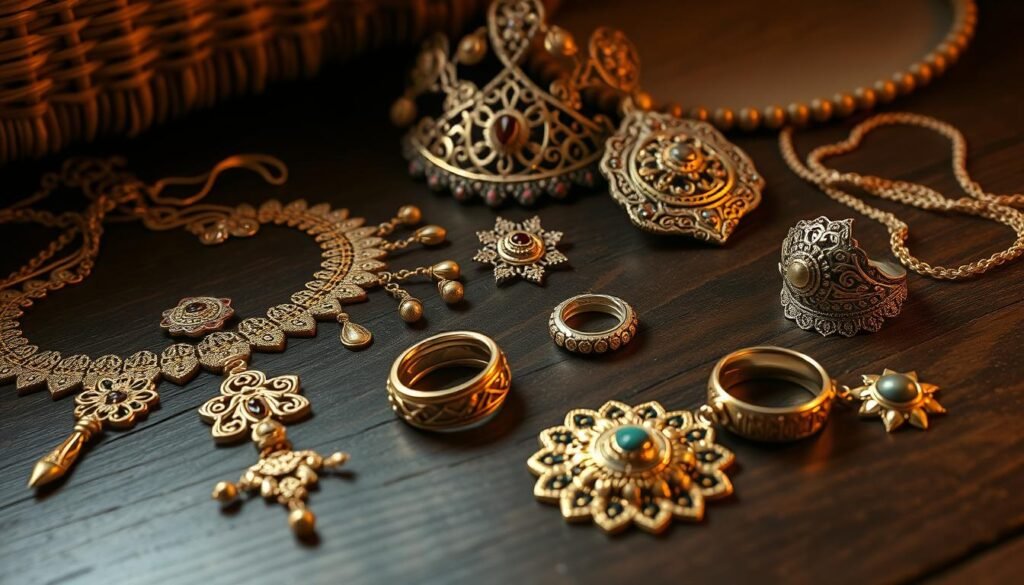
Pre-Colonial Influences and Traditional Techniques
Pre-colonial artisans used techniques like handweaving and gold filigree to create intricate designs. The Bolinao Skull, for example, showcases gold dental decorations resembling fish scales. This practice highlights the importance of adornments in expressing beauty and prestige.
In Surigao, gold-wire waistbands displayed a unique loop-in-loop technique. These pieces, dating back to the 10th–13th century, were unparalleled in the Malay-Javanese world. Such craftsmanship demonstrates the advanced skills of Filipino goldsmiths.
Cultural Symbols and Storytelling in Adornments
Every design element in ancient Filipino adornments carried meaning. Symbols and motifs often echoed beliefs and rituals. For instance, a necklace worn by a datu symbolized authority and wealth during meetings.
Similarly, a ring might feature floral motifs, replacing earlier religious symbols over time. These pieces served as mediums for passing down folklore and ancestral wisdom, preserving cultural identity.
| Artifact | Technique | Significance |
|---|---|---|
| Bolinao Skull | Gold dental decorations | Beauty and prestige |
| Surigao Waistbands | Loop-in-loop technique | Advanced craftsmanship |
| Datu’s Necklace | Gold filigree | Authority and wealth |
Exploring Design and Craftsmanship
The artistry behind Filipino adornments reveals a deep connection to culture and tradition. Each piece is a testament to the skill and creativity of local artisans. From intricate rings to detailed bracelets, these designs blend history with modern innovation.
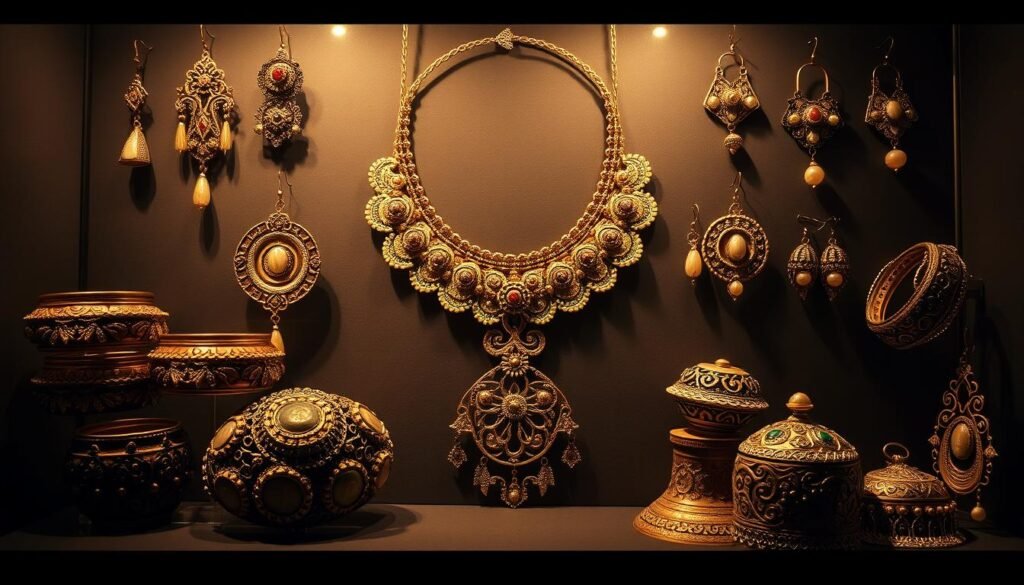
Local Materials and Artistry
Filipino artisans use locally sourced materials to ensure authenticity. Gold, brass, and natural fibers are transformed into stunning adornments. This commitment to local resources supports communities and preserves traditional methods.
Modern Interpretations of Ancient Designs
Contemporary designers are reimagining ancient motifs for today’s audience. Techniques like leaf-folding and Temwel brass-casting are being revived. These modern interpretations honor the past while appealing to current tastes.
Reviving Lost Techniques: From Leaf-Folding to Temwel
Lost techniques are making a comeback thanks to dedicated artisans. Leaf-folding, a pre-colonial art, is being reintroduced with precision. Similarly, Temwel brass-casting celebrates Indigenous craftsmanship. These efforts ensure that ancient skills are not forgotten.
“Every design tells a story, blending heritage with innovation.”
Through meticulous craftsmanship and cultural reinvigoration, Filipino adornments continue to inspire. Each piece is a celebration of artistry, tradition, and innovation.
Product Roundup: Timeless Jewelry Pieces
Discover the artistry behind Filipino-made pieces that have stood the test of time. From elegant rings to intricate necklaces, each creation reflects a blend of tradition and modern style. These adornments are not just accessories—they are stories of heritage and craftsmanship.
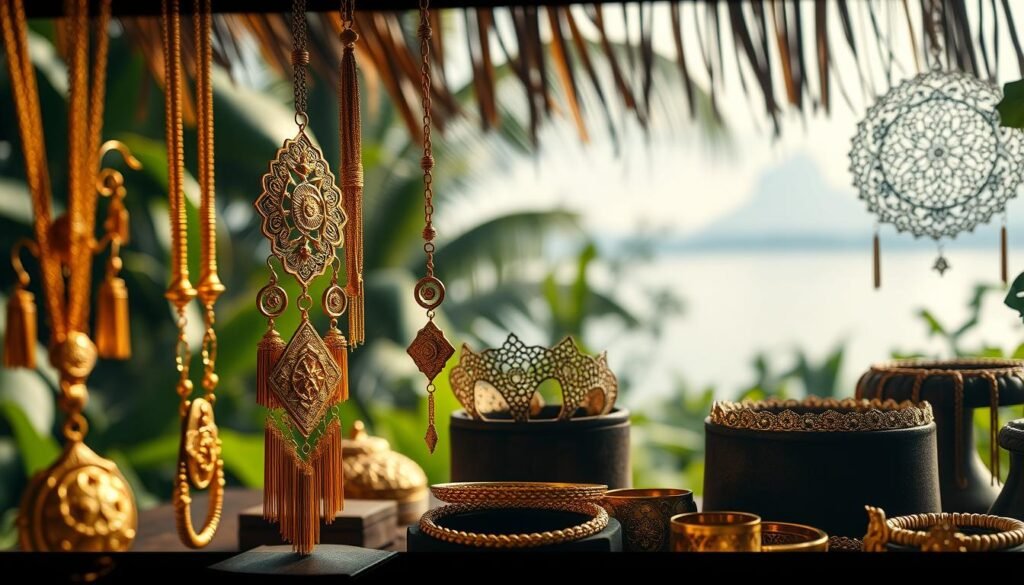
Elegant Rings and Intricate Necklaces
Filipino artisans craft rings that are both delicate and bold. For example, the Spinelli Kilcollin Raneth MX mixed metal ring showcases a unique design that blends silver and gold. This piece is perfect for those who appreciate modern elegance.
Necklaces like the Missoma coterie chain necklace feature intricate details that make them versatile for any occasion. Whether worn casually or formally, these necklaces add a touch of sophistication to any outfit.
Statement Bracelets and Other Unique Pieces
Statement bracelets, such as the Dorsey Kate rivière bracelet, are designed to make an impact. With lab-grown white sapphires set in gold, this piece is both ethical and stunning. It’s a testament to the blend of tradition and innovation.
Other unique pieces include the Agmes domed ring set, which combines simplicity with boldness. These rings are perfect for stacking, allowing you to create a personalized look.
| Product | Material | Design Feature |
|---|---|---|
| Spinelli Kilcollin Raneth MX Ring | Mixed Metal | Modern Elegance |
| Missoma Coterie Chain Necklace | Gold | Intricate Detailing |
| Dorsey Kate Rivière Bracelet | Gold, Lab-Grown Sapphires | Ethical Craftsmanship |
| Agmes Domed Ring Set | Gold | Stackable Design |
These pieces are more than just adornments—they are a celebration of Filipino artistry. To learn more about the cultural significance behind these designs, explore our guide on ancient Filipino scripts.
Understanding the Role of Jewelry in Filipino Culture
In Filipino culture, adornments are more than just accessories—they are symbols of identity and heritage. From ancient times to the present, these pieces have played a vital role in expressing cultural pride and storytelling. Each design carries a unique narrative, blending tradition with artistry.
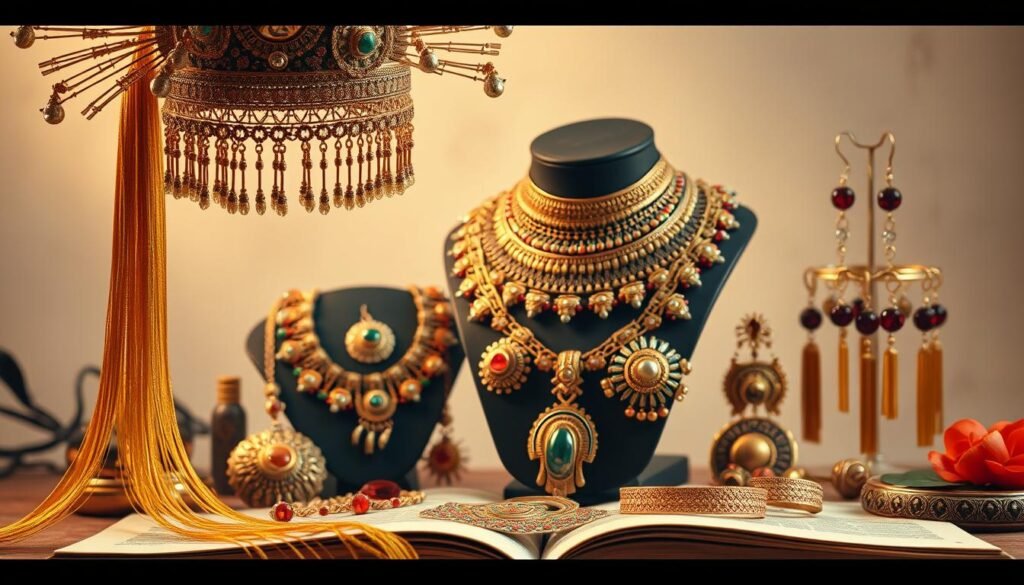
Cultural Significance and Ethnic Identity
Adornments in Filipino culture are deeply rooted in ethnic identity. A necklace worn by a datu, for example, symbolized authority and wealth. Similarly, a ring might feature floral motifs, reflecting personal or familial stories. These pieces are not just decorative—they are expressions of cultural continuity and pride.
Indigenous techniques, such as gold filigree and brass-casting, highlight the advanced skills of Filipino artisans. These methods, passed down through generations, contribute to national pride and cultural preservation. For more on traditional brass-casting, explore this detailed guide.
Symbols, Styles, and Social Traditions
Every design element in Filipino adornments carries meaning. Symbols often echo ancestral beliefs and rituals. For instance, a bracelet might feature intricate patterns representing protection or prosperity. These styles have evolved over time, from bold clay pieces to delicate gold designs.
Social customs also elevate these adornments to cultural icons. During celebrations, specific pieces are worn to honor traditions and showcase heritage. Modern interpretations of these designs continue to celebrate Filipino artistry while appealing to contemporary tastes. Learn more about these styles in this comprehensive article.
| Adornment | Symbolism | Cultural Role |
|---|---|---|
| Necklace | Authority and Wealth | Worn by leaders |
| Ring | Personal Stories | Family heirlooms |
| Bracelet | Protection and Prosperity | Celebratory wear |
“Adornments are not just pieces of art—they are the soul of our culture, telling stories of who we are.”
Through ethical craftsmanship and true-to-tradition designs, Filipino adornments continue to inspire. They are a celebration of heritage, artistry, and the enduring spirit of Filipino culture.
How to Shop for Unique and Ethical Filipino Jewelry
Finding unique and ethically crafted Filipino adornments is easier than ever with trusted brands and mindful shopping practices. Whether you’re looking for a statement bracelet or a meaningful heirloom, understanding how to shop responsibly ensures your purchase supports artisans and preserves cultural heritage.
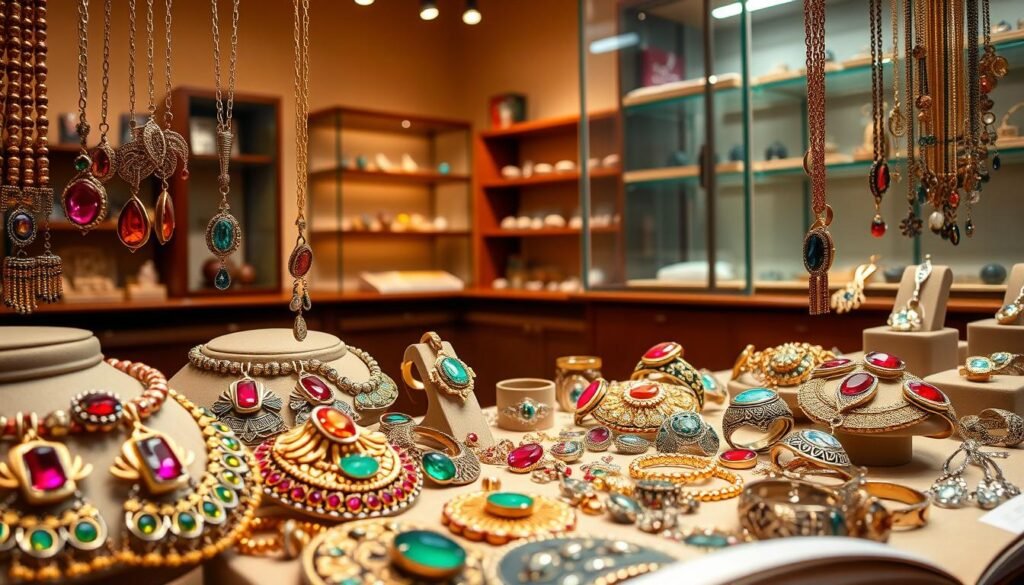
Vetted Brand Partners and Sustainable Craftsmanship
When shopping for Filipino adornments, it’s essential to choose brands committed to ethics and sustainability. Brands like AMAMI and Sesotunawa are vetted for their transparency, use of local materials, and fair compensation for artisans. These partners ensure every piece is crafted with care and respect for tradition.
For example, AMAMI collaborates with metalsmiths across the Philippines to revive ancient techniques like gold filigree. Sesotunawa, on the other hand, celebrates Tboli culture through handcrafted brass designs. By supporting these brands, you contribute to the preservation of endangered crafts and sustainable livelihoods.
Tips for a Personalized and Mindful Shopping Experience
To make your shopping experience meaningful, start by researching the cultural significance of the pieces you’re interested in. Look for brands that provide detailed information about their artisans and processes. This ensures authenticity and a deeper connection to the craftsmanship.
Here are some actionable tips to guide your purchase:
- Verify the brand’s commitment to sustainability and ethical practices.
- Explore collections online to find pieces that resonate with your style.
- Consider the versatility of the design—can it be worn for multiple occasions?
- Take advantage of benefits like free delivery and hassle-free returns.
| Brand | Specialty | Ethical Practices |
|---|---|---|
| AMAMI | Gold Filigree | Supports artisans, revives traditions |
| Sesotunawa | Brass Jewelry | Celebrates Tboli culture, community-based |
| En Route Handcrafted | Wooden Earrings | Empowers Indigenous artisans |
By shopping mindfully, you not only acquire beautiful adornments but also support the artisans and communities behind them. For more inspiration, explore this guide to Filipino jewelry brands that celebrate heritage and artistry.
Conclusion
Ancient Filipino adornments are more than just beautiful pieces—they are a testament to a rich cultural heritage. From the intricate goldwork of pre-colonial times to the modern interpretations of today, these designs bridge the past and present. Each piece carries a story, reflecting the artistry and traditions of Filipino craftsmanship.
Ethical practices and sustainability are at the heart of preserving these traditions. By choosing ethically sourced pieces, you support artisans and help keep ancient techniques alive. This ensures that every creation honors its cultural roots while meeting modern standards.
Exploring Filipino adornments is an invitation to connect with a vibrant history. Whether it’s a necklace or a ring, each design is a celebration of identity and artistry. Dive deeper into this fascinating world and discover how tradition and innovation come together to create timeless pieces. Learn more about the evolution of adornments in this comprehensive guide.
FAQ
What materials are commonly used in traditional Filipino jewelry?
Traditional Filipino jewelry often uses local materials like gold, silver, pearls, and indigenous gemstones. Artisans also incorporate natural elements such as shells, wood, and woven fibers.
How does Filipino jewelry reflect cultural storytelling?
Filipino jewelry often features symbols and designs that tell stories of heritage, spirituality, and community. These pieces serve as wearable art that preserves and shares cultural narratives.
Are there modern interpretations of ancient Filipino jewelry designs?
Yes, many contemporary designers blend ancient techniques with modern aesthetics. This fusion creates unique pieces that honor tradition while appealing to today’s fashion trends.
What are some traditional techniques used in Filipino jewelry-making?
Techniques like leaf-folding, temwel (filigree), and intricate metalwork are integral to Filipino jewelry-making. These methods have been passed down through generations and are still practiced today.
Where can I shop for authentic and ethical Filipino jewelry?
Look for vetted brands and artisans who prioritize sustainable craftsmanship. Many shops and online platforms specialize in ethically sourced and culturally significant Filipino pieces.
What should I consider when buying Filipino jewelry?
Focus on the craftsmanship, materials, and cultural significance of the piece. Ensure the brand supports fair trade practices and preserves traditional techniques for a mindful shopping experience.
What makes Filipino jewelry unique compared to other styles?
Filipino jewelry stands out for its rich cultural symbolism, use of local materials, and intricate craftsmanship. Each piece often carries a story or meaning tied to Filipino heritage and identity.
Source Links
- A Brief History Of Philippine Gold Jewelry
- Exploring the Rich Heritage of Filipino Jewelry: A Testament to Culture and Craftsmanship – Mustaqim
- A brief history of jewelry in the Philippines
- A Brief History Of Philippine Gold Jewelry
- Alahas: The Book That Tells The Story Of Philippine Jewelry
- The Art of Jewelry Design — Irden Jewelry & Appraisals
- The Craftsmanship Factor: How Design Influences Jewelry Value – Publish What You Pay
- The Craftsmanship Behind Fine Jewelry Design – JD Institute of Fashion Technology
- We Asked Our Editors Which Pieces of Jewelry They Never Take Off
- Timeless Jewelry Pieces That Are Worth Their Value – WE magazine for women
- What is traditional Filipino tambourine jewelry?
- Philippine Traditional Accessories: Must-Have Jewelry, Bags, and Hats
- Ruanne Catapang honors Filipino culture through her shop's jewelry collections – Daily Bruin
- 5 Filipino Jewelry Brands To Complement Your Unique Style
- AMAMI | Celebrating Traditional Filipino Heritage Jewelry
- Jewelry | Materials, Methods, History, & Facts | Britannica
- Jewellery

